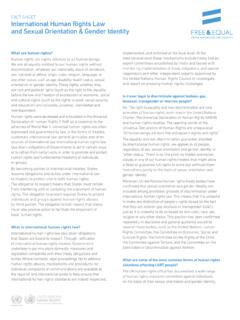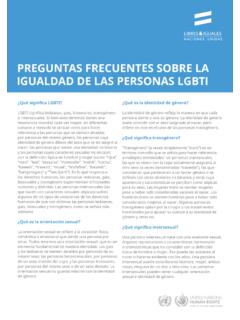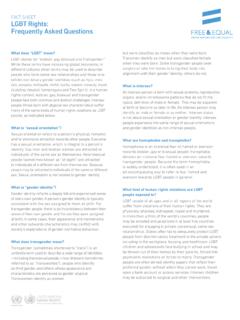Transcription of Fact sheet Homophobic and transphobic violence
1 violence against lesbian, gay, bisexual or transgender peopleHomophobic and transphobic violence has been reported in all regions of the world. It ranges from aggressive, sustained psychological bullying to physical assault, torture, kidnapping and targeted killings. Sexual violence has also been widely reported, including so-called corrective or punitive rape, in which men rape women assumed to be lesbian on the pretext of trying to cure their victims of homosexuality. violence takes place in a variety of settings: on the street, in public parks, in schools, in workplaces, in private homes, and in prisons and police cells.
2 It may be spontaneous or organized, perpetrated by individual strangers or by extremist groups. A common characteristic of many anti-LGBT hate crimes is their brutality: murder victims, for example, are often found mutilated, severely burnt, castrated, showing signs of sexual assault. Transgender persons, especially those involved in sex work or in detention, face an especially high risk of deadly and extremely cruel and ill-treatment of lesbian, gay, bisexual, transgender and intersex people has also been extensively documented. Often, torture occurs in places of detention, where LGBT people may be victimized by police officers, prisons guards, or their own peers while State agents turn a blind eye.
3 Some forms of involuntary medical treatment may also be tantamount to torture, including anal examinations of gay men to prove their homosexuality, unwanted sterilization of transgender people and forced electric shock therapy intended to change someone s sexual orientation. DataOfficial data on Homophobic and transphobic violence is patchy and official statistics are scarce. Relatively few countries have adequate systems in place for monitoring, recording and reporting Homophobic and transphobic hate crimes. Even where such systems exist, victims may not trust the police enough to come forward, and the police themselves may not be sufficiently sensitized to recognize and properly record the motive.
4 Nevertheless, by piecing together whatever national statistics are available and supplementing them with reporting from other sources a clear pattern emerges of widespread, brutal violence , often committed with impunity. State responsibilityStates are obliged under international law to protect LGBT people s rights to life, to security of person, and to freedom from torture and ill-treatment. States have a heightened responsibility to take measures to prevent hate-motivated killings, violent attacks and torture, to investigate such crimes promptly and thoroughly and to bring those responsible to justice.
5 Action pointsStates: Investigate, prosecute and punish perpetrators responsible for targeted killings. Enact hate crime laws aimed at deterring violence on the basis of sexual orientation and gender identity. Establish systems for recording and reporting hate-motivated violence . Provide law enforcement, detention staff, judges and other security sector personnel with appropriate sensitivity training. Develop public education and information campaigns to counter Homophobic and transphobic attitudes and promote values of diversity and mutual , your friends and other individuals can make a difference too: Make sure you and those around you have zero tolerance for any form of Homophobic or transphobic violence , including aggressive and threatening verbal abuse.
6 Speak out and report all such violence , even when it does not regard you directly. If you or your friends or family members were a victim of hate-motivated violence alert UN human rights special procedures by sending an email to Fact sheet Homophobic and transphobic violenceGender-based violence Attacks on people because of their sexual orientation or gender identity are often driven by a desire to punish those seen as defying gender norms and are considered a form of gender-based violence . You do not need to be lesbian, gay, bisexual, transgender or intersex to be attacked: the mere perception of homosexuality or of transgender identity is enough to put people at s Violent Backlash?
7 In several countries, the authorities have noted a dramatic spike in Homophobic and transphobic violence in the immediate aftermath of high- profile legislative advances aimed at better protecting the rights of LGBT people. It is a phenomenon with historic parallels: past attempts to eradicate racial segregation and discrimination reportedly triggered a similar backlash directed at members of racial minorities. It is the responsibility of governments not just to address discrimination but also to explain to the wider public why action is needed, and to make sure that adequate measures are in place to prevent and respond promptly and effectively to violence when it Walsh was 13 when he walked into the garden of his family s home in Tehachapi, California, and hanged himself.
8 Before making the tragic decision to end his life, he had endured years of Homophobic taunting and abuse from his peers at school and in his neighbourhood. Seth s case is not isolated: in the same month in which he died, at least five other teenage boys in the United States also committed suicide after suffering at the hands of Homophobic Zamudio, a 24 year-old gay man, died as a result of severe injuries sustained during a vicious assault by a group of alleged neo-Nazis in a Santiago park. He was allegedly tortured for several hours by his attackers, who stubbed cigarettes out on him and carved swastikas into his body.
9 Four suspects were detained and charged with Daniel s murder. Some of those arrested had criminal records for previous attacks on gay men. The prosecutor has said that he believes the attacks were clearly motivated by homophobia. New laws on Homophobic hate crimes and discrimination were adopted in the aftermath of the attack, which generated a public outcry and provoked a national debate about (not her actual name), a transgender woman (meti) was arrested by police in Kathmandu, taken to a local police station and allegedly verbally abused and commanded her to strip.
10 When she refused, the police officers present reportedly stripped her clothes forcibly and touched her genitals while mocking her, and threatened to cut her hair off as punishment for wearing women s clothes. She was released the next day. Similar incidents involving police harassment of metis are reported regularly and often involve physical beatings and verbal African LGBT rights activist Noxolo Nogwaza was 24 when she was raped and murdered in KwaThema township near Johannesburg. Her face and head were disfigured by stoning and she had been stabbed several times with broken glass.









